Are Hummingbirds Territorial at Feeders and Flowers?
Updated: May 15, 2024
If you've seen hummingbirds fighting and chasing each other, you might wonder if hummingbirds are territorial. Learn how to feed multiple hummingbirds.
On This Page
Why Are Hummingbirds So Territorial?
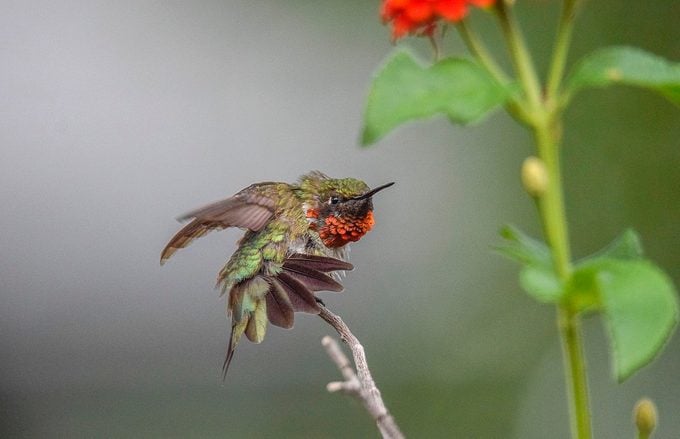
A hummingbird is a wonder to behold as it dances in the air to sip sweet nectar from flowers. You might imagine that such a delicate lover of sweetness would be among the most peaceful creatures in the world. In reality, whenever two or more hummingbirds are present, things can get a little tense. The feisty birds zoom about, sparring in midair or chasing each other with chattering cries—relentless in their desire to defend their spaces. Usually when you see a male hummingbird at a feeder, you only see one. And there’s a reason for that. Male hummingbirds are territorial. Here’s what you need to know about this common hummingbird behavior.
Hummingbirds Compete for Nectar Sources
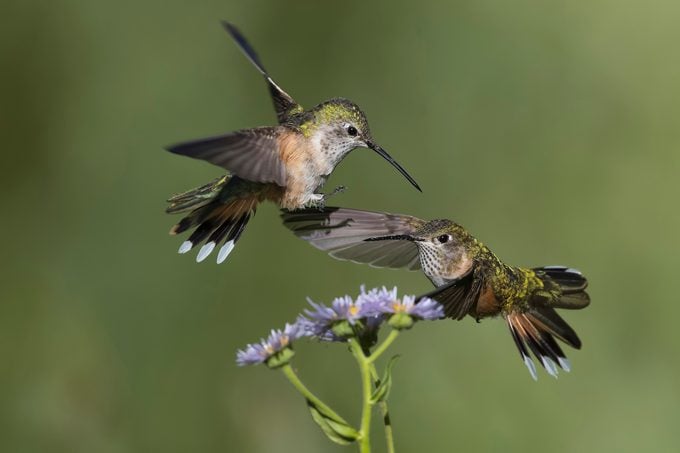
Male hummingbirds are very territorial and can be remarkably feisty about defending their food sources. It makes sense considering that flowers, their primary source of nectar, last for only a limited time. A hummingbird that stakes out a good patch of blooms may defend that finite resource with great gusto.
Hummingbirds, butterflies, bees and other pollinators each have a relationship with flowers that benefits both sides. Flowers produce nectar, which is rich in sugar, to attract these creatures. In turn, the birds and insects pick up pollen from one flower and carry it to another, helping the plant to reproduce. But each bloom produces only a small amount of nectar at a time. If a hummingbird finds a group of flowers, it may visit them one at a time, taking sips from each while waiting for the others to replenish.
A good flower patch might keep a hummingbird supplied with food all day—but only as long as the hummer can keep other fliers away. When a hummingbird finds a stand of wildflowers or a blooming tree or vine, it may be easier for the hummer to defend the plant against competitors than to find another nectar source.
So these birds have an instinct to quickly start protecting a feeding territory around the nectar supply they’ve discovered. It’s likely to be only temporary, and the hummingbird may soon shift to another spot, but the instinct to guard a food source is always there.
Why Won’t Hummingbirds Share a Feeder?
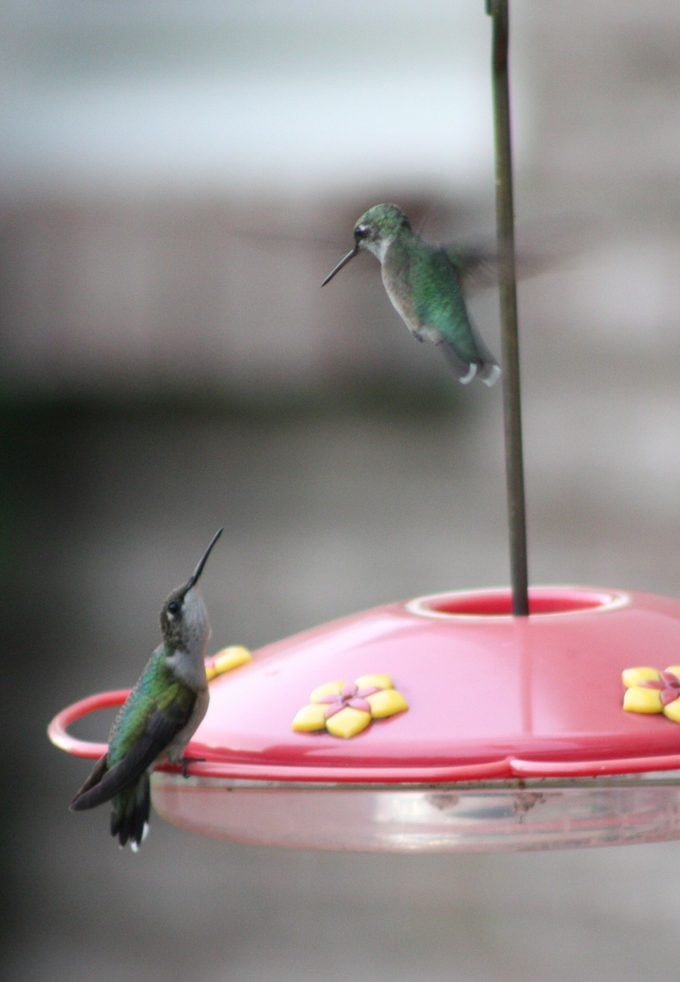
“I never get more than one hummingbird at a time at my feeders. How can I encourage them to share?” asks reader Cheryl Vandermark of Wallkill, New York.
When male hummingbirds defend one of your feeders, they’re exhibiting the same territorial behavior. A hummingbird’s territorial instinct is so strong that it often carries over to situations where it’s not as needed—for example, at hummingbird feeders with an endless supply of sugar water. Some individuals are more aggressive than others and therefore are more likely to dominate a single feeder.
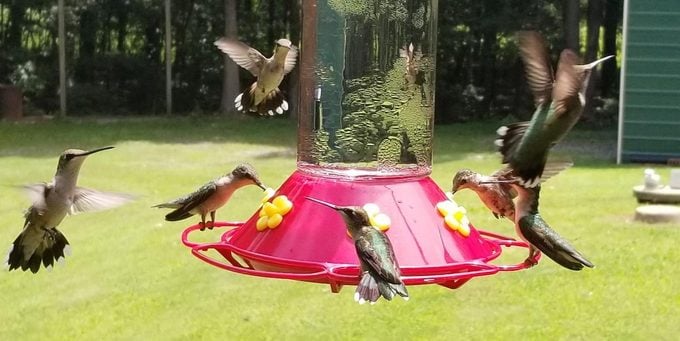
Hummingbirds have an instinct to protect their food sources, because in nature, a patch of flowers will produce only so much nectar in a day. The tiny birds carry this defensiveness over to artificial feeders. So no matter how often you refill your feeder, the hummingbirds don’t realize that they don’t have to fight over it. One aggressive individual may try to dominate a whole row of feeders, zooming in to drive away every other bird.
The best solution is to put your sugar-water feeders farther apart, so one bird can’t control them all. Or better yet, put the feeders out of sight of each other, perhaps on different sides of your house or in spots separated by trees. If that isn’t possible, you may have an overly pushy solo hummingbird controlling your feeders until it decides to move on.
Pursuing a Mate
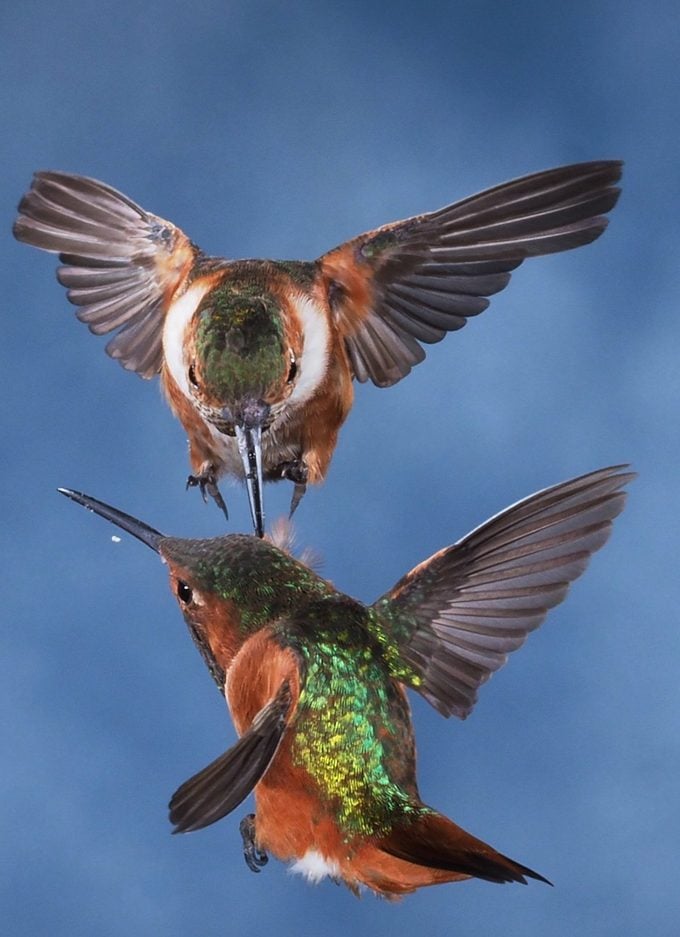
In the breeding season, a male hummingbird establishes a different kind of territory. He surveys his surroundings from a high perch. If another male shows up, he’ll chase it away. If a female hummingbird appears, he’ll start putting on his courtship display—often performing aerial acrobatics, with loud whirring or whistling sounds—to catch her attention. After they mate, though, that’s the end of their relationship, and he goes back to watching for more females.
When the female builds her nest, it may or may not be in his territory. In the meantime, she’ll defend a small territory of her own, chasing away other females that come too close to her nest.
Hummingbirds are a joy to watch, and they become even more fascinating when we understand the reasons behind some of their actions. You may get to observe these territorial behaviors in your own backyard.
How Do I Feed Multiple Territorial Male Hummingbirds?
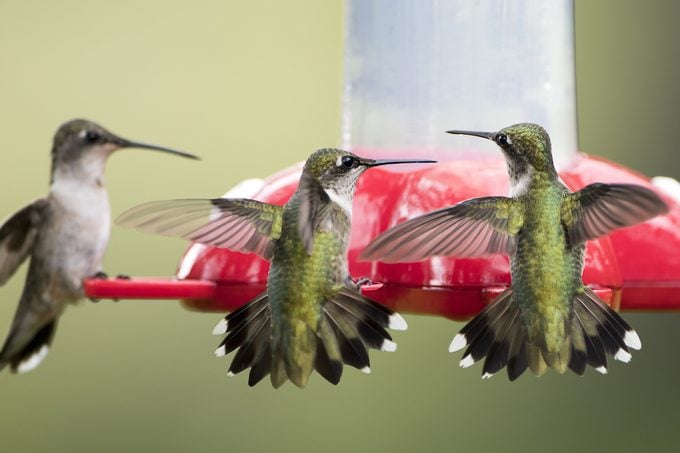
To feed multiple male hummingbirds, you’ll need some space. Provide more than one feeder and grow nectar-rich native plants.
When setting up multiple feeders, try to place them at least 15 feet apart. If the layout of your outdoor space allows, put the feeders out of sight of each other. When the male hummingbirds can’t see each other, they won’t be as busy chasing each other away.
Also, to see more of these fliers, provide plenty of nectar plants that will supply shelter and help attract the small insects hummingbirds rely on for protein. Tube-shaped red and orange flowers are common hummer favorites. Visit your local native plant nursery and ask for their suggestions.
Hummingbirds Are Less Territorial During Migration

The intensity of their defense varies by season. In their nesting territories in summer, they may fiercely chase away all rivals. During migration, when they’re just passing through an area, they have less incentive to defend anything. Hummingbird festivals are usually held at migratory stopover sites, where large numbers of hummers may pause only briefly, tolerating each other’s presence while they swarm the feeders.
Are Female Hummingbirds Territorial?
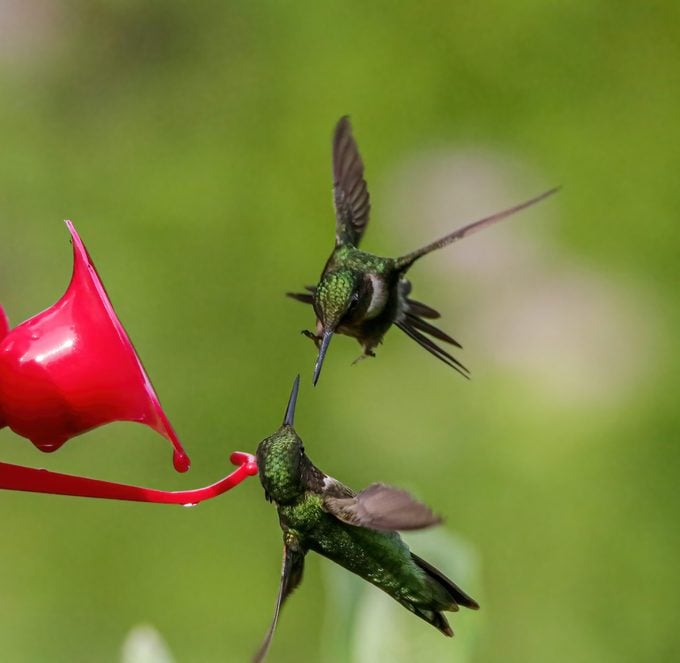
“One female hummingbird chases all other hummingbirds away from our sugar-water feeder. We’ve added several more feeders, but she keeps growing her territory. What should we do?” asks Sue Evanecko of Manorville, New York.
Individual birds vary in personality, and some hummingbirds are absurdly aggressive in defending food sources. When your feeders have been adopted by overprotective sprites, it’s a challenge to outwit them. If the layout of your yard allows, try positioning feeders on opposite sides of the house so it is impossible to see them all at once. Or place two or three feeders close together, and then another one as far away as possible.
The hyper-aggressive bird will probably move on in a month or two anyway. And for the future, planting more hummingbird preferred native flowers should reduce competition for the feeders.
Other Examples of Territorial Bird Behavior
Many birds have specific ways of keeping potential intruders out of their claimed spaces.
- Carolina wren pairs stay together to defend a permanent territory with songs and calls year-round.
- A male red-winged blackbird sings to announce a domain in the marsh for himself and his multiple mates, but only in the breeding season.
- Belted kingfishers protect feeding areas along rivers, chasing away other kingfishers that approach.
Why Trust Us
For nearly 30 years, Birds & Blooms, a Trusted Media Brand, has been inspiring readers to have a lifelong love of birding, gardening and nature. We are the #1 bird and garden magazine in North America and a trusted online resource for over 15 million outdoor enthusiasts annually. Our library of thousands of informative articles and how-tos has been written by trusted journalists and fact-checked by bird and garden experts for accuracy. In addition to our staff of experienced gardeners and bird-watchers, we hire individuals who have years of education and hands-on experience with birding, bird feeding, gardening, butterflies, bugs and more. Learn more about Birds & Blooms, our field editor program, and our submission guidelines.





















